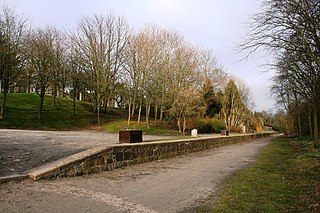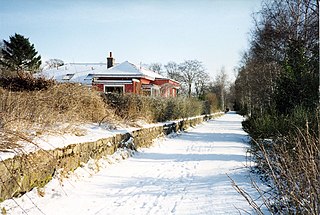
Banchory is a burgh or town in Aberdeenshire, Scotland. It is about 18 miles (29 km) west of Aberdeen, near where the Feugh River meets the River Dee.

The River Dee is a river in Aberdeenshire, Scotland. It rises in the Cairngorms and flows through southern Aberdeenshire to reach the North Sea at Aberdeen. The area it passes through is known as Deeside, or Royal Deeside in the region between Braemar and Banchory because Queen Victoria came for a visit there in 1848 and greatly enjoyed herself. She and her husband, Prince Albert, built Balmoral Castle there which replaced an older castle.

Railway preservation in New Zealand is the preservation of historically significant facets of New Zealand's rail transport history. The earliest recorded preservation attempt took place in 1925, although the movement itself did not start properly until 1960.

The Great North of Scotland Railway (GNSR) was one of the two smallest of the five major Scottish railway companies prior to the 1923 Grouping, operating in the north-east of the country. Formed in 1845, it carried its first passengers the 39 miles (63 km) from Kittybrewster, in Aberdeen, to Huntly on 20 September 1854. By 1867 it owned 226+1⁄4 route miles (364.1 km) of line and operated over a further 61 miles (98 km).

The Royal Deeside Railway is a Scottish heritage railway located at Milton of Crathes railway station on a part of the original Deeside Railway.

The Deeside Way is a 41-mile (66 km) rail trail that follows, in part, the bed of the former Deeside Railway in Aberdeenshire. Forming part of the National Cycle Network the trail leads from Aberdeen to Ballater.

The Deeside Railway was a passenger and goods railway between Aberdeen and Ballater in Aberdeenshire, Scotland. Opening in 1853 to Banchory, an extension reached Aboyne in 1859. A separate company, the Aboyne & Braemar Railway, built an extension to Ballater and this opened in 1866. By 1855 there were five services a day over the 43+1⁄4-mile (69.6 km) long line, taking between 1 hour 50 minutes and 2+1⁄2 hours. The line was used by the Royal Train for travel to and from Balmoral Castle from 1853 and a special 'Messenger Train' ran daily when the Royal Family was in residence.

Milton of Crathes is a complex of restored 17th-century stone buildings, associated with, and previously an outlier of, Crathes Castle in Aberdeenshire, Scotland. The site is presently used for retail and restaurant purposes.

Culter railway station was opened on 8 September 1853 by the Deeside Railway and served the town of Peterculter that is locally known as Culter. The Deeside Railway was taken over by the GNoSR and in 1894 Culter was the terminus for the Aberdeen suburban service although a few trains continued to Banchory. Despite the 1937 closure of many other stations on the Aberdeen suburban service, Culter remained open until 1966 as an intermediate station on the Deeside Railway that ran from Aberdeen (Joint) to Ballater. Culter is located in the parish of Peterculter, Aberdeenshire, Scotland.

Banchory railway station was situated on the Aberdeen and Ballater branch. It was situated at 16 miles 72 chains (27.2 km) from Aberdeen, and was the terminus of the railway from its opening on 8 September 1853 until extension to Aboyne in 1859. The branch was extended to its final terminus at Ballater in 1866.

Lumphanan railway station, Lumphanan, Aberdeenshire, Scotland stood from 1859 to 1966 on the Deeside Railway that ran from Aberdeen (Joint) to Ballater. It served the village of Lumphanan, Aberdeenshire, famous for its associations with Macbeth and King Malcolm III. It stood close to the Macbeth Arms Hotel.

Murtle railway station, later Murtle Halt railway station served Murtle and Beaconhill Houses and estates, the Mill of Murtle, Milton of Murtle, the local farms and the inhabitants of this rural area within the parish of Peterculter from 1853 to 1937 on the Deeside Railway that ran from Aberdeen (Joint) to Ballater.

Milltimber railway station served the Milltimber area within the parish of Peterculter from 1854 to 1937 on the Deeside Railway that ran from Aberdeen (Joint) to Ballater. This area at that time had a number of mansion houses, estates, etc. such as Culter House, Fairgirth House, Camphill House, Avondow House, Glasterberry House, etc. whose workers, etc. would have used the station. Milltimber was only a short distance from Murtle station. The station was named for the nearby Milltimber Farm.

Bieldside railway station served the Bieldside area within the parish of Peterculter from 1897 to 1937 on the Deeside Railway that ran from Aberdeen (Joint) to Ballater. This area was the location of a number of mansion houses and estates such as Woodthorpe, Dalmunzie, The Firs, etc., some built as a result of the railway.

West Cults railway station served the small suburban village of West Cults area within the parish of Peterculter from 1894 to 1937 on the Deeside Railway that ran from Aberdeen (Joint) to Ballater. It lay very close to Cults and Bieldside.

Cults railway station was opened on 8 September 1853 by the Deeside Railway and served part of Cults with mansion houses such as Southfield, Wellwood, Woodbank, Inchgarth, Drumgarth and Norwood nearby. The Deeside Railway station was replaced in 1855 by a new GNoSR that remained open, despite the 1937 closure of many other stations on the Aberdeen suburban service, until 1966 as an intermediate station on the Deeside Railway that ran from Aberdeen (Joint) to Ballater. Cults is located in the parish of Peterculter, Aberdeenshire, Scotland.

Ruthrieston railway station or Ruthrieston Halt was opened in January 1856 by the GNSR and served Ruthrieston, now a suburb of Aberdeen. The halt was one of several victims of the 1937 closure of stations on the Aberdeen suburban service. The Deeside Railway itself eventually ran from Aberdeen (Joint) to Ballater. Ruthrieston is located in the parish of Peterculter, Aberdeenshire, Scotland.
Drum railway station was opened in January 1854 by the Deeside Railway and served the rural area around Drum Castle estate. The Deeside Railway was taken over by the GNoSR and in 1894 nearby Culter became the terminus for the majority of Aberdeen suburban services with only a few trains continuing through Drum to Banchory. Despite the 1937 closure of many other stations on the Aberdeen suburban service, Drum remained open until 1951 as an intermediate station on the Deeside Railway that ran from Aberdeen (Joint) to Ballater. Drum station was located in Drumoak Parish, Aberdeenshire, Scotland.
Mills of Drum railway station was opened in September 1853 by the Deeside Railway and served the rural area around Park House and Crathes estates at the Mills of Drum or Drum Mills, corn mills, that lay close to the River Dee. The Deeside Railway was taken over by the GNoSR in the 1860s. Mills of Drum only remained open until 1863 as an intermediate station on the Deeside Railway that ran from Aberdeen (Joint) to Ballater. Mills of Drum station was located in Deeside, Aberdeenshire, Scotland.

Park railway station was opened in September 1853 by the Deeside Railway and served the rural area around the Park estate, Nether Sunnyside, West Redford and the hamlet of Park. The Deeside Railway was taken over by the GNoSR and in 1894 nearby Culter became the terminus for the majority of Aberdeen suburban services with only a few trains continuing through Park to Banchory. Despite the 1937 closure of many other stations on the Aberdeen suburban service, Park remained open until 1966 as an intermediate station on the Deeside Railway that ran from Aberdeen (Joint) to Ballater. Park station was located in Drumoak Parish, Aberdeenshire, Scotland.


















